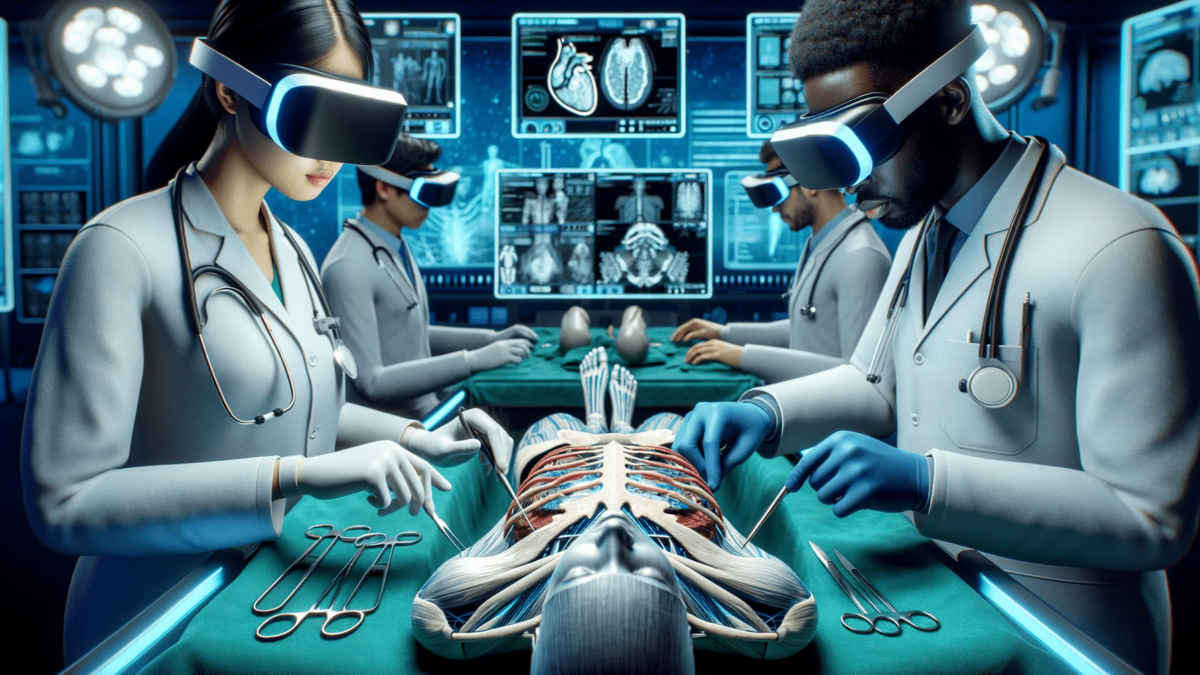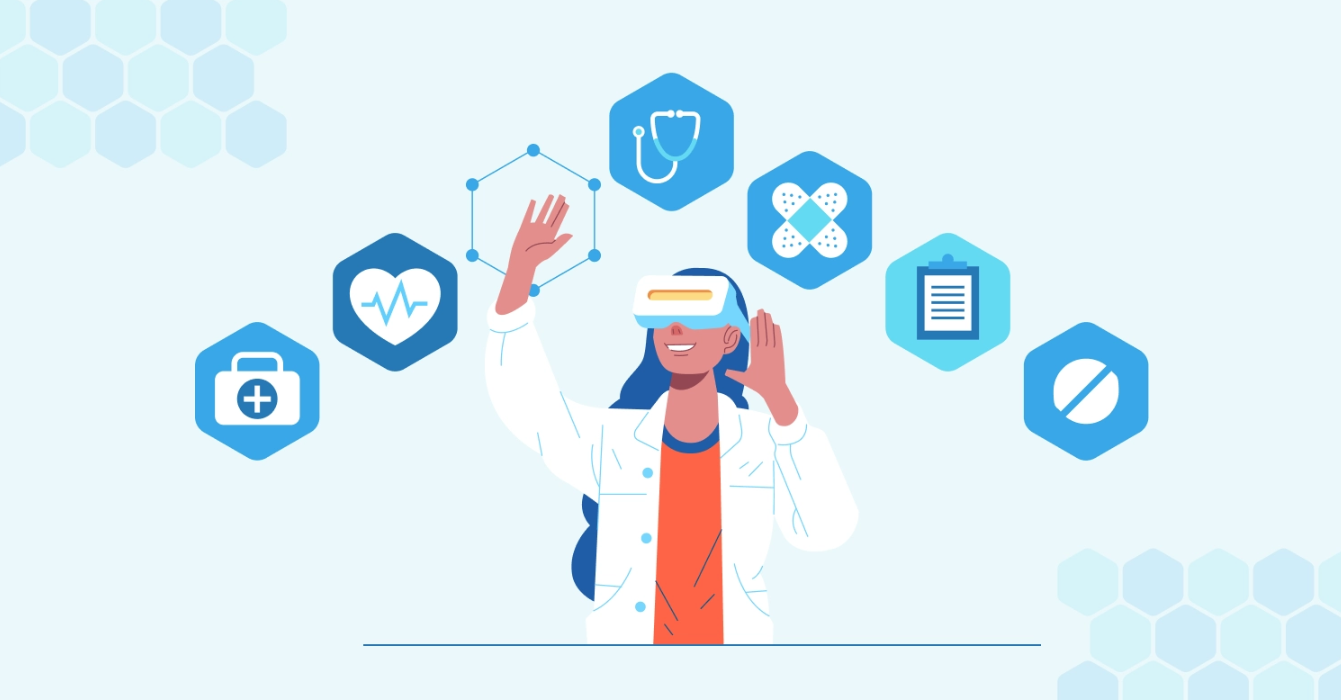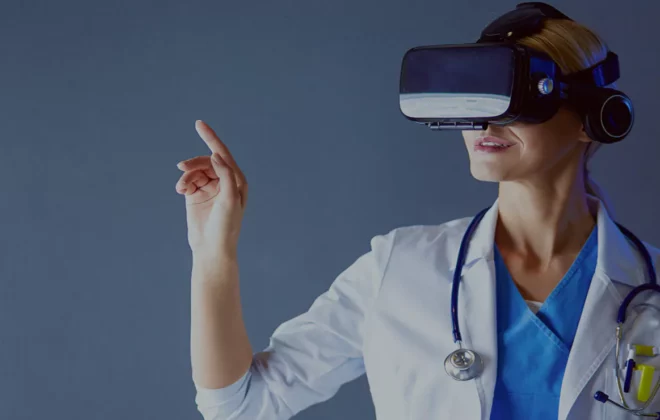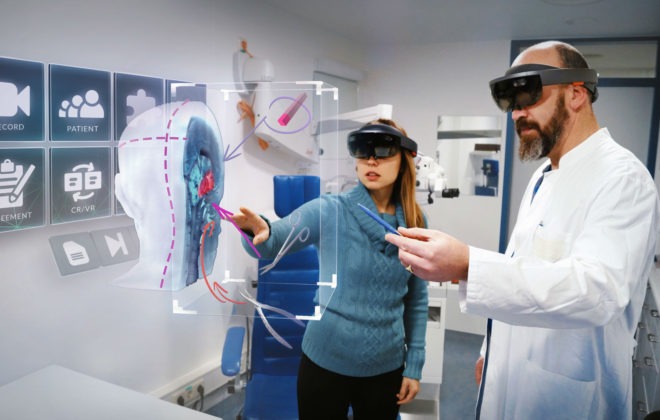Choosing the Right VR Platform for Healthcare Training: A Comprehensive Guide
VR healthcare training is fast becoming popular in the medical sector and is transforming the way that doctors are taught and educated. Promising to improve the quality and efficacy of medical education, this creative approach provides immersive, hands-on experiences unlike anything else that conventional approaches could equal.
Introduction to VR in healthcare
Virtual reality medical education is the use of VR technology to create virtual settings where healthcare professionals may practice and refine their abilities. From basic anatomical investigations to advanced surgical operations, these settings provide students a secure and regulated environment to acquire experience free from the hazards connected with practical training.
This article seeks to guide medical facilities and practitioners in selecting the finest healthcare training courses. Understanding the main characteristics and contrasting the best healthcare platforms helps readers make wise judgments to satisfy their training requirements.
The Importance of VR in Healthcare Training
☛ Current Training Challenges
Many times, traditional training approaches lack enough chances for practical experience which is very essential for learning difficult techniques. Often depending on simulations with mannequins, restricted practical sessions that do not adequately prepare them for real-life settings, or seeing seasoned experts, students and trainees often find themselves
In practical instruction, the margin of error is quite small. Errors could have major effects on patients, creating a high-stress situation wherein trainees would not feel free to explore or grow from their errors.
Traditional instruction calls for personal presence, which might be difficult for those living far distances or with schedule issues. This limits access to chances for further education and top-notch training.
☛ Advantages of VR
Trainees may repeatedly conduct a variety of operations and situations in VR’s realistic, interactive environment free of harm to actual patients. Developing expertise and confidence depends on this practical experience. For instance, VR surgical simulations let students perform difficult operations with a degree of realism not possible with more conventional approaches.
VR provides a secure environment where one may make errors and grow from them. Trainees are free to try many methods and approaches without worrying about injuring someone. This promotes a more honest and comprehensive learning process, therefore fostering deeper knowledge and improved skill retention.
VR lets learners attend courses from anywhere at any time, therefore removing the need for physical presence. Professionals looking for ongoing education while juggling their schedules and remote students especially benefit from this adaptability.
 Key Features to Look For in a VR Healthcare Training Platform
Key Features to Look For in a VR Healthcare Training Platform
☛ Interactivity and Immersion
The degree of interaction and immersion in VR training for healthcare professionals is vital. Interactive scenarios and realistic simulations enable students to really connect with the content, therefore enhancing their knowledge and memory of difficult medical ideas.
☛ Content Library
Effective immersive medical education depends on a thorough and adjustable content collection. To meet the many demands of healthcare workers, the platform should provide a large spectrum of training courses encompassing several medical specialties and operations.
☛ Ease of Use
Trainers and trainees equally depend on easy-to-use interfaces. The platform should be simple and straightforward to use, therefore lowering the learning curve and enabling users to concentrate on their training instead of battling with the technology.
☛ Scalability
Every kind of institution depends on scalability. From small group events to extensive programs, the platform should be able to meet different training demands without sacrificing performance or quality.
☛ Analytics and Reporting
Essential parts of a good training platform include tools for monitoring development, evaluating performance, and offering comments. These tools help trainers to track student progress and spot areas requiring work, therefore guaranteeing that training goals are reached.
☛ Integration Capabilities
Integration with current systems and devices improves the usefulness and flexibility of the platform. Using current resources and infrastructure, seamless integration makes a training experience more coherent.
 Leading VR Platforms for Medical Education
Leading VR Platforms for Medical Education
☛ Platform 1: Osso VR: Overview, Main Attributes, Benefits and Drawbacks, Perfect Use
Leading VR platform Osso VR is designed with surgical training and medical education in mind. It offers a realistic, simulation-based, immersive environment where doctors may hone their surgical techniques.
Key features
- Offers realistic, high-resolution simulations of several surgical techniques.
- Using thorough analytics and feedback, performance analytics tracks trainee performance.
- Virtual operating rooms allow one to practice difficult surgical techniques repeatedly.
- With a range of courses, scalable training is fit for both big universities and individual students.
Benefits
- Offers very realistic surgical simulations closely reflecting real-life situations.
- Detailed performance data enable learners to pinpoint areas needing work.
- Encouragement of trainees to practice free from the possibility of injuring actual patients helps to develop confidence and skill.
Drawbacks
- Cost: Smaller organizations or individuals may find the platform less accessible due to its often costly nature.
- Specialization: Mostly concentrated on surgical education, so its use in other medical disciplines might be limited.
Perfect use cases
- Ideal for individuals wishing to hone surgical procedures, surgical residents and trainees are also perfect.
- Perfect for hospitals and medical schools trying to improve their surgical training courses are medical institutions.
☛ Platform 2: VirtaMed: Overview, Main Attributes, Benefits and Drawbacks, Perfect Use
VirtaMed provides cutting-edge VR simulation solutions for urology, gynecology, and surgery, among other medical specialties. It focuses on offering interactive, highly detailed training opportunities.
Key features
- High-Fidelity Simulations: Provides procedural scenarios and realistic simulations with thorough anatomical models.
- Interactive Training Modules: Interactive Training Modules offer step-by-step directions and real-time comments.
- Customizable Content: Provides training courses to satisfy certain requirements.
Benefits
- Versatility: It addresses many medical fields outside of surgery.
- Detailed Assessments: To monitor trainee development, detailed examinations and certification programs provide track-through capability.
- Customization: Flexible material is able to be customized to certain training requirements.
Drawbacks
- There may be a need for more sophisticated training and configuration to make good utilization.
- High-fidelity simulations and enhanced capabilities may be expensive.
Perfect Use Cases
- Medical Professionals Across Disciplines: Appropriate for instruction in several disciplines, including gynecology and urology, medical professionals across disciplines
- Healthcare Institutions: Perfect for those looking for complete training programs spanning many disciplines.
☛ Platform 3: Touch Surgery: Overview, Main Attributes, Benefits and Drawbacks, Perfect Use
For surgical instruction, Touch Surgery offers a reasonably affordable and easily available VR platform. By use of realistic simulations and instructional materials, it seeks to democratize access to premium training.
Key features
- Realistic Surgical Simulations provide a spectrum of interactive, tactilely feedback surgical situations.
- Training courses, tests, and instructional movies comprise the educational resources.
- Data tracking and reporting follow development and offer comprehensive performance analyses.
Benefits
- Affordability: More organizations can use cost-effective solutions.
- Comprehensive Content: Many tools for continuous education and skill development assist in this regard.
- Easy of Use: Appropriate for a broad spectrum of consumers, the interface is welcoming.
Drawbacks
- It mostly concentrates on surgical training, which may not meet all medical training requirements and has a limited scope.
- Performance monitoring may not be as thorough as some of premium systems.
Perfect Use Cases
- Appropriate educational institutions seeking reasonably priced but efficient surgical teaching equipment include medical schools and training programs.
- Ideal for professionals looking for continuous education and skill development free from physical presence is remote and continuing education.
☛ Platform 4: Apple Vision Pro: Overview, Main Attributes, Benefits and Drawbacks, Perfect Use
Apple Vision Pro presents a new high-quality VR and AR-based platform that integrates real and virtual environments. It is expected to offer realistic and realistic simulations that will advance the training of health care personnel through graphics and interactivity.
Key Features:
- Details are displayed in high resolution creating clear visuals necessary for medical exactness.
- Ensures soundscapes that are realistic and enhance the learning environment and the overall learning process.
- It uses both augmented and virtual approaches for a more versatile form of learning.
- Carrying M2 and R1 chips for optimization during complicated functions and operations.
Benefits:
- Immersive Learning: Allows the specific examination of anatomical models and performs simulated surgeries without any actual danger in the process.
- Natural Interaction: The eye and hand tracking enable perfect handling of the virtual tools which in turn makes the learning process easier.
- Engagement: This aspect enhances student focus and knowledge, particularly in areas of interest such as surgery.
- Collaborative Opportunities: Enables distance learning teaching and enables medical professionals to train together in a virtual environment.
Drawbacks:
- High Cost: The premium price may restrict access for smaller institutions or individuals.
- Limited Initial Content: There may be few strictly medical training applications, though there are likely to be more in the future.
- Battery Life: There may be a limited battery capacity in the device which may not allow long training sessions.
Perfect Use Cases:
- Perfect for the universities with medical schools, teaching hospitals, and surgical training courses requiring the best and precise simulation.
- Teaching and learning complicated structures, and interprofessional interaction wherein people can interact even without being in the same physical location.
Comparative Analysis
When evaluating the best VR platform for healthcare, one should take into account elements like interaction, content library, simplicity of use, scalability, analytics, and integration powers. Every platform has special benefits; the ideal one will rely on the particular demands and objectives of the healthcare facility.
| Feature | Osoo VR | VirtaMed | Touch Surgery | Apple Vision Pro |
|---|---|---|---|---|
| Interactivity | High | Moderate | High | High |
| Content Library | Comprehensive | Comprehensive | Customizable | Comprehensive |
| Ease of Use | Moderate | High | Moderate | Moderate |
| Scalability | High | High | High | High |
| Analytics and Reporting | Advanced | Moderate | Advanced | Advanced |
| Integration Capabilities | Moderate | High | Moderate | Moderate |
| Cost | High | Moderate | High | High |
Case Studies and Success Stories
☛ Case Study 1: Jump Medical Visualization (MedVis) at OSF HealthCare
OSF HealthCare has integrated VR and AR into its training programs, significantly enhancing the educational experience for both students and professionals. Dr. Matthew Bramlet, and his team at the Jump Advanced Imaging and Modeling combined VR in lectures and planning surgery, using VR in the identification of arrhythmias and in cardiovascular physiology. By converting or splitting ordinary lectures into VR, they were able to cut training duration by at least half and consequently enhance the learner’s participation and effectiveness. Currently, the application of this approach is extending itself to several other medical disciplines within the OSF network, and that is why can be defined as a great success story of the use of VR to support healthcare education.
☛ Case Study 2: Monarch Healthcare Management Using UbiSim VR Platform
Monarch Healthcare Management implemented the UbiSim VR platform across 22 sites to standardize pain management training for nurses. They found that the use of the actual improved the consistency of the education provided through various facilities. This use of VR was highly cited as advantageous, effective, and noteworthy for improving care by enabling the repeated practice of those essential skills with reduced risk for the patient. The initiative portrays how VR is exceptionally efficient in standardizing and raising the degree of medical training within a massive corporation.
Implementation and Best Practices
☛ Getting Started with VR
Using VR training for medical professionals calls for many actions.
- Find the particular training requirements and objectives of your company.
- Choose one platform. Select a VR platform that fits your needs most precisely.
- Make sure trainees are knowledgeable in utilizing the platform to enhance its efficiency.
- Roll out the training to every learner and use the analytics features of the platform to track advancement constantly.
- Get comments from staff members and trainees to pinpoint areas that want work.
- Make required changes depending on performance data and comments to keep the training program always better.
☛ Customization tips
VR content’s efficacy may be much improved by being tailored to certain training requirements. These guidelines help you to personalize your immersive medical education:
- Sort the most important abilities and processes that need development.
- Work with medical specialists to produce reasonable and accurate simulations.
- Incorporate real-world situations that trainees most likely may come across.
- Maintaining the most recent medical practices and technology, keep the material current.
- Use user comments to help to hone and enhance the training courses.
☛ Common Pitfalls
Putting VR training into use for medical practitioners might present difficulties. These are some typical mistakes and how to stay clear of them:
- Insufficient Training for Trainers: Trainers should have thorough instructions on how to use the VR platform.
- Ignoring Technical help: Make sure any potential problems have enough technical help to handle.
- Ignoring User Feedback: Frequent gathering and action on user comments will help to enhance the training process.
- Underestimating Costs: Know all expenses, including maintenance, hardware, and software.
Future Trends in VR Healthcare Training
☛ Emerging Technologies
VR healthcare training is being continually improved by developing technology. These are a few trends worth observing:
- Artificial Intelligence (AI): Artificial intelligence (AI) may improve VR simulations by offering each student more realistic and flexible settings, hence customizing the learning process.
- Augmented Reality (AR): Combining VR and AR will provide hybrid settings wherein virtual aspects are superimposed onto the actual world, therefore improving the realism of the training.
- Haptic Feedback: Advances in haptic technology may provide tactile feedback, therefore giving simulations a more realistic and immersive feel.
- 5G Connectivity: Particularly in distant training situations, better connection will allow more responsive VR experiences.
☛ VR’s role in the future
Medical education is about to become even more dependent on VR healthcare instruction. VR will become more accessible and reasonably priced as technology develops, therefore enabling more institutions to gain from its benefits. Future advances may consist of:
- VR systems might link doctors all over, therefore enabling group training and knowledge exchange.
- VR may provide premium instruction to underprivileged or rural places, therefore resolving differences in healthcare education.
- VR will be essential for ongoing professional development as it will help medical practitioners to stay current with the most recent developments in their domains.
Conclusion
Training in virtual reality healthcare has several advantages over more conventional approaches. It offers realistic, immersive experiences meant to improve information retention, skill development, and participation. Important characteristics of a VR platform should include interactivity, a large content library, simplicity of use, scalability, analytics and reporting, and integration possibilities. Healthcare organizations may greatly enhance their training initiatives by carefully choosing the correct platform and adhering to best standards for application.
☛ Call to action (CTA)
Explore InfoseMed’s products to find out more about how VR platforms could transform your healthcare training initiatives. Our experience putting medical VR systems into use guarantees that you get the most customized and powerful training opportunities.
☛ Contact information
Contact InfuseMed now for a consultation or demo of our VR training for medical professionals. Call or visit our website. With Infosemed’s innovative VR solutions, embrace the direction in which medical education is headed.
Blog Categories
- 3D Animation (5)
- Company News (2)
- Design Graphics (1)
- Healthcare Operations (7)
- Industry News (9)
- Medical Training (1)
- Sales Enablement (5)
- Software Developing (3)
- Virtual/Augmented Reality (11)


 Key Features to Look For in a VR Healthcare Training Platform
Key Features to Look For in a VR Healthcare Training Platform Leading VR Platforms for Medical Education
Leading VR Platforms for Medical Education

